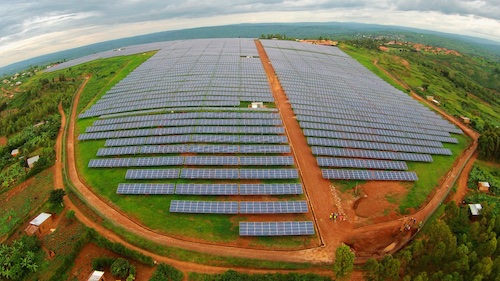The Rwanda field, a $23.7 million, 8,5 MW solar energy plant has been connected to the power grid. Developed by Gigawatt Global, this is the first utility-scale project to reach financial close and come online under the Africa Clean Energy Finance (ACEF) program that is part of the Power Africa Initiative. The Rwanda field – constructed in the shape of the African continent – brought together an international consortium of financing partners.
Rwanda’s Minister of Infrastructure, Hon. James Musoni, and the Chief of Staff of the U.S. Government’s Overseas Private Investment Corporation (OPIC), John Morton, led a ribbon-cutting ceremony at the Agahozo-Shalom Youth Village (ASYV) near where the solar plant is located.
“Top quality developers like Gigawatt Global are the keys to success for President Obama’s Power Africa Initiative,” said Elizabeth Littlefield, president and CEO of OPIC. “After OPIC provided critical early-stage support through the ACEF program, Gigawatt smoothly and swiftly brought the project online to give Rwanda enough grid-connected power to supply 15,000 homes. Gigawatt Global in Rwanda is a clear demonstration that solar will be a key part of Africa’s energy solution.” The project was completed in one year.
 Chaim Motzen, Gigawatt Global Co-Founder and Managing Director, and the main force behind the development of the project, noted, “Our project proves the viability of financing and building large-scale solar fields in sub-Saharan Africa, and we hope that this solar field serves as a catalyst for many more sustainable energy projects in the region. The speed with which this project was completed is a tribute to the strength of the Rwandan government’s institutions and their laser-focus on increasing Rwanda’s generation capacity as well as to the nimbleness of our team and partners which spanned eight countries.”
Chaim Motzen, Gigawatt Global Co-Founder and Managing Director, and the main force behind the development of the project, noted, “Our project proves the viability of financing and building large-scale solar fields in sub-Saharan Africa, and we hope that this solar field serves as a catalyst for many more sustainable energy projects in the region. The speed with which this project was completed is a tribute to the strength of the Rwandan government’s institutions and their laser-focus on increasing Rwanda’s generation capacity as well as to the nimbleness of our team and partners which spanned eight countries.”
The Rwandan project is built on land owned by the Agahozo-Shalom Youth Village, whose mission is to care for Rwanda’s most vulnerable children orphaned before and after the Rwandan genocide. The Village is leasing land to house the solar facility, the fees from which will help pay for a portion of the Village’s charitable expenses. Gigawatt Global will also be providing training on solar power to students of the Liquidnet High School on the grounds of the Youth Village.
“This utility-scale solar field at the Agahozo-Shalom Youth Village is a symbol of hope for sub-Saharan Africa’s tens of millions of orphans and 600 million people without power, ushering in a new era of impact investing that we will hopefully be replicating throughout Africa,” added Yosef Abramowitz, president of Gigawatt Global. “We want to thank President Obama and Secretary Kerry, along with our other financial partners, for the opportunity to celebrate this landmark electricity-generating project under Power Africa.”








